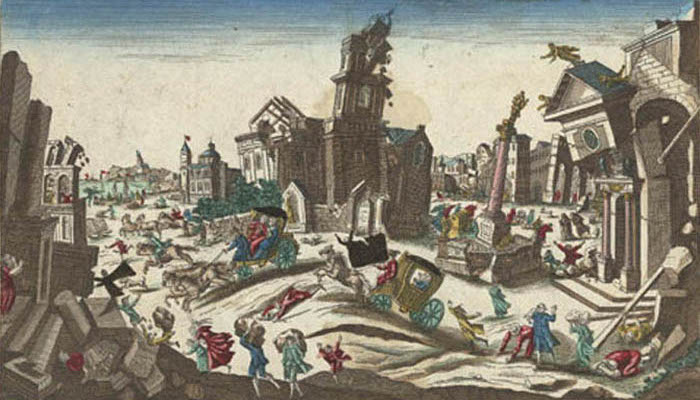Southern Italy and Sicily experience regular earthquakes and volcanic eruptions. However, the earthquakes of early 1783 did not follow the normal pattern of one strong quake and weaker fore- and/or aftershocks. Instead, there was a seismic sequence of five strong earthquakes. A seismic sequence is an unusual event, in which one earthquake increases the stress on other parts of the fault system, which triggers subsequent earthquakes. This process is called Coulomb stress transfer.As a sign of how dire contemporary observers thought of these quakes, Kleemann quotes an account sent to the Royal Society by Sir William Hamilton, the British ambassador to the Kingdom of the Two Sicilies:
The Earthquakes in Italy were, perhaps, the most terrible and destructive of any that have happened since the Creation of the World. Four hundred towns, and about four or five times as many villages, were destroyed in this dreadful calamity. The number of lives lost, are estimated at between forty and fifty thousand.Hamilton had already published papers about Italy’s earthquakes and volcanos. In 1770 He had even won a medal from the Royal Society for one. But he’s better known in history for his second wife’s love affair with Lord Nelson, fictionalized by Susan Sontag in The Volcano Lover.
Kleemann continues:
At the time, it was believed that sulfuric fogs were a precursor to strong earthquakes, a dry fog was observed in the days before the 1755 Lisbon earthquake – most likely produced by an eruption of the Icelandic volcano Katla. A similar fog was also reported in Calabria on February 4, 1783.As discussed back here, in early 1784 Benjamin Franklin linked the Laki volcano to the dry fog and speculated that it affected the weather in Europe. (Of course, he also suggested the atmospheric haze might have been caused by meteors, so we mustn’t think Franklin got everything right.)
We now know that the Icelandic Laki Fissure eruption, of 1783, released large amounts of gases and ash, which were carried towards continental Europe via the jet stream. However, news of this took almost three months to reach Europe, by which time the dry fog had vanished again, making it difficult to explain the phenomenon at the time.
The sheer number of unusual subsurface phenomena observed during this time seemed overwhelming. Many theories were developed to explain the “year of awe,” one suggested the Calabria earthquakes had created a crack in the Earth, which was releasing the sulfuric fog observed over Europe. . . .
In the late eighteenth century, it was believed that all volcanoes, most often coined “fire (spitting) mountains,” were connected via fire channels inside the Earth. Earthquakes and volcanic eruptions were believed to be caused by chemical reactions—between gas or metals and water for instance—in subterranean passages and caverns.

No comments:
Post a Comment